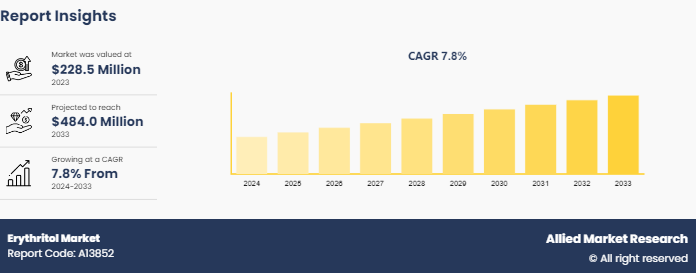Erythritol Market Research, 2033
The global erythritol market size was valued at $228.5 million in 2023, and is projected to reach $484.0 million by 2033, growing at a CAGR of 7.8% from 2024 to 2033.

Market Introduction and Overview
Erythritol is a low-calorie sugar alcohol used as a sweetener in various sugar-free and low-sugar products. It stands out among other sugar alcohols due to its significantly lower calorie content, providing only 0.24 calories per gram compared to table sugar’s 4 calories per gram. Despite its minimal caloric value, erythritol delivers about 70% of the sweetness of regular sugar. Produced through the fermentation of glucose derived from corn or wheat starch, erythritol appears as white, powdery crystals. While it offers a sweet taste without the calories, it may cause digestive issues when consumed in large amounts and has been linked to concerns about blood clots and heart problems in some studies. Overall, erythritol is valued for its natural sweetness and minimal caloric impact but should be consumed in moderation to avoid potential side effects.
Key Takeaways
- The erythritol market analysis covers 20 countries. The research includes a segment analysis of each country in terms of value ($million) for the projected period from 2024 to 2033.
- More than 1, 500 product literatures, industry releases, annual reports, and other such documents of major industry participants along with authentic industry journals, trade associations' releases, and government websites have been reviewed for generating high-value industry insights.
The study integrates high-quality data, professional opinions and analysis, and critical independent perspectives. The research approach intends to provide a balanced view of global markets and assist stakeholders in making informed decisions in order to achieve their most ambitious growth objectives.
Key Market Dynamics
Erythritol, a sugar alcohol, has become a popular choice for those looking to reduce calorie intake or manage sugar consumption. Its key benefits include a negligible effect on blood sugar and insulin levels, making it suitable for diabetics. Erythritol is also almost calorie-free, with only 0–0.2 kilocalories per gram, which supports weight management. Unlike many sugar alcohols, erythritol is absorbed well in the small intestine, reducing the risk of gastrointestinal distress. It does not cause osmotic diarrhea or significant fermentation by gut bacteria, unlike other sugar alcohols such as xylitol. These factors are anticipated to boost the erythritol market growth in the upcoming years.
While erythritol is generally recognized as safe (GRAS) by the FDA it can pose potential risks for some individuals. Gastrointestinal effects, such as nausea, bloating, and diarrhea, may occur, although these are typically less severe compared to other sugar alcohols. In addition, some research suggests a possible link between erythritol consumption and an increased risk of cardiovascular events, including blood clot formation, heart attack, and stroke.
Erythritol presents notable opportunities across various fields due to its unique properties and expanding applications. As a phase change material (PCM) , erythritol's high energy storage density and non-corrosive nature make it valuable for medium temperature energy storage, with potential uses in solar heat collection and waste heat recovery. Despite challenges like supercooling and low thermal conductivity, ongoing research aims to enhance erythritol’s performance through improved thermal management strategies. In addition, erythritol’s status as a low-calorie, tooth-friendly sugar substitute drives its rising popularity in the food industry. These factors are anticipated to have positive impact on the erythritol market forecast opportunities.
Analysis of the Erythritol Market
Several key players in the global market specialize in the production and distribution of erythritol, a popular sugar substitute. These companies range from manufacturers focusing on high-purity chemicals to distributors providing a wide array of industrial materials.
Below is a summary of notable companies involved in the erythritol supply chain, along with their roles, locations, and company profiles:
Company Name | Role | Location | Overview |
United States Biological | Manufacturer/Supplier | Salem, Massachusetts, U.S. | Specializes in life science research products including biochemicals and molecular biology kits. |
Wego Chemical Group Inc | Distributor | Great Neck, New York, U.S. | Full-service supplier and distributor of chemicals across various markets including food & beverage. |
Univar Solutions Inc. | Distributor | The Woodlands, Texas, U.S. | Provides chemicals and value-added services to a wide range of industries, including food and pharmaceuticals. |
Kanto Chemical Co., Inc. | Manufacturer | Tokyo, Japan | Reagent manufacturer with a broad product portfolio and international presence, including analytical and specialty chemicals. |
Mitsubishi Chemical Corporation | Manufacturer | Tokyo, Japan | Provides chemicals, industrial gases, and healthcare products, with a focus on functional food materials and pharmaceuticals. |
Market Segmentation
The erythritol market is segmented based on form, application, and region. On the basis of form, the market is divided into powder and granular. On the basis of application, the market is classified into beverage, bakery, confectionery, and dairy products, personal care, pharmaceutical, and others. Region wise, the market is analyzed across North America, Europe, Asia-Pacific, and LAMEA.
Country Market Outlook
Erythritol, a popular sugar substitute, has been gaining traction in China due to its unique benefits and market demand. Henan Yuxin Sugar Alcohol Co. LTD, a prominent domestic producer, has been a key player in the erythritol market for nearly thirty years.
According to Ning Jun from Yuxin, erythritol stands out among sugar substitutes due to its zero-calorie profile, making it particularly appealing in a market increasingly focused on health and low-calorie options.
The current market in China for erythritol is vibrant, with applications spanning beverages, confectionery, bakery items, jams, and even oral care products such as toothpaste and mouthwash.
Its versatility is a significant advantage, allowing it to be used across a wide range of products without strict usage restrictions. However, the industry faces challenges related to erythritol's high production costs compared to other sweeteners, which can limit its widespread adoption.
Competitive Landscape
The key players operating in the erythritol market are Cargill, Shandong Sanyuan Biotechnology Co., Ltd., Tate & Lyle, Zhucheng Dongxiao Biotechnology Co., Ltd., JUNGBUNZLAUER SUISSE AG, Nikken Chemical Laboratory Co., Ltd., Futaste Co., Ltd., Baolingbao Biology Co., Ltd., Foodchem International Corporation, Unterhofer & Partner KG, and others.
Recent Key Strategies and Developments
- In January 2024, recent research has revealed that erythritol inhibits the growth of Staphylococcus coagulans (SC) strains isolated from canine pyoderma. The study showed that erythritol upregulated genes associated with sugar uptake and inhibited SC growth in vitro, affecting both methicillin-resistant and sensitive strains. Notably, erythritol's growth inhibition could be reversed by glucose, indicating glucose starvation's role in this effect. These findings suggest erythritol's potential as a novel antimicrobial agent against bacterial infections in dogs, though further research is needed to confirm its practical efficacy.
In March 2021, the research study published in the journal Nature, unveiled key insights into the β-fructofuranosidase enzyme from Schwanniomyces occidentalis, which is crucial for producing fructooligosaccharides and fructo-conjugates. Structural studies revealed that mutations in Gln-176, Gln-228, and Asn-254 significantly impact the enzyme's ability to transfructosylate alditols like mannitol and erythritol. Notably, the N254T variant enhanced fructosyl-erythritol and fructooligosaccharides (FOS) production by 30% and 48%, respectively, showcasing improved efficiency. These findings offer new avenues for optimizing biotechnological applications involving this enzyme.
Erythritol Industry Trends
- A study from the Cleveland Clinic links erythritol, a common artificial sweetener, to increased blood clotting risk. On August 20, 2024, researchers found that consuming just 30 grams of erythritol less than in a can of soda led to increased platelet activation, potentially raising the risk of heart attacks or strokes. While erythritol is FDA-approved as ‘generally recognized as safe’, the findings suggest a need for further investigation into its long-term effects. Experts recommend limiting consumption of sweetened products and opting for natural sweeteners or whole foods.
In February 2024, a research study published in the journal Springer Nature, highlighted erythritol's potential as a mosquito control agent that revealed mixed results. The study found that while erythritol caused significant diuresis and increased mortality in adult Aedes aegypti when paired with sucrose, it had no effect on larvae and was less effective when mosquitoes were not resource-deprived. Erythritol, a competitive inhibitor of α-glucosidase, demonstrates some promise as an insecticide but lacks the necessary efficacy for immediate use in vector control programs. Further research is needed to enhance its effectiveness.
Key Benefits For Stakeholders
- This report provides a quantitative analysis of the market segments, current trends, estimations, and dynamics of the erythritol market share from 2023 to 2033 to identify the prevailing erythritol market opportunities.
- The market research is offered along with information related to key drivers, restraints, and opportunities.
- Porter's five forces analysis highlights the potency of buyers and suppliers to enable stakeholders make profit-oriented business decisions and strengthen their supplier-buyer network.
- In-depth analysis of the erythritol market segmentation assists to determine the prevailing market opportunities.
- Major countries in each region are mapped according to their revenue contribution to the global market.
- Market player positioning facilitates benchmarking and provides a clear understanding of the present position of the market players.
Apart from the points mentioned above, the report includes the analysis of the regional as well as global erythritol market trends, key players, market segments, application areas, and market growth strategies.
Key Sources Referred
- Tate & Lyle
- National Institutes of Health
- American Chemical Society
- NutritionFacts.org
- World Health Organization
Erythritol Market Report Highlights
| Aspects | Details |
| Market Size By 2033 | USD 484.0 Million |
| Growth Rate | CAGR of 7.8% |
| Forecast period | 2024 - 2033 |
| Report Pages | 300 |
| By Form |
|
| By Application |
|
| By Region |
|
| Key Market Players | Foodchem International Corporation, Shandong Sanyuan Biotechnology Co., Ltd., baolingbao biology co.,ltd., Cargill, Zhucheng Dongxiao Biotechnology Co., Ltd., Nikken Chemical Laboratory Co., Ltd., Futaste Co., Ltd., Tate & Lyle, Jungbunzlauer Suisse AG, Unterhofer & Partner KG |
The erythritol market size is estimated to reach $484.0 million by 2033.
Increasing demand for low-calorie and sugar free products along with rising popularity of plant-based natural products are the upcoming trends in the market.
Asia-Pacific is the largest regional market for erythritol.
The jams segment is anticipated to show the fastest growth during the forecast period.
The top companies to hold the high market share in the erythritol market are Cargill, Shandong Sanyuan Biotechnology Co., Ltd., Tate & Lyle, Zhucheng Dongxiao Biotechnology Co., Ltd., JUNGBUNZLAUER SUISSE AG, Nikken Chemical Laboratory Co., Ltd., Futaste Co., Ltd., Baolingbao Biology Co.,Ltd., Foodchem International Corporation, and Unterhofer & Partner KG.
Loading Table Of Content...



